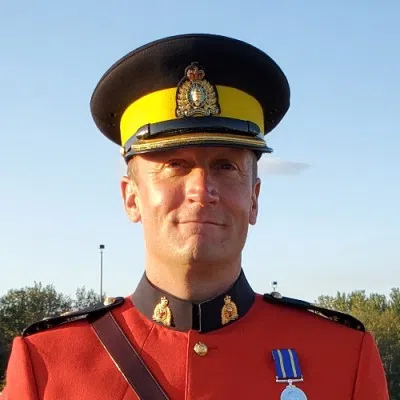
Chief Superintendent Mark Hancock OIC Wood Buffalo Detachment, Mark Hancock. Image via Linkedin
Policing and the Public: The changing face of the RMWB
This is the first in a series on policing in the Regional Municipality of Wood Buffalo (RMWB). Harvard Media News recently sat down with Chief Superintendent Mark Hancock, Officer in Charge of the Wood Buffalo RCMP Detachment.
Hancock is a 33-year veteran of the RCMP. As a child, he took the game of “cops and robbers” to the next level, often dressing in a Red Serge his mother made for him. His fascination with the national police force never wavered, and he applied to join immediately after finishing university.
His first introduction to Fort McMurray came during the tail end of the oil boom in the early 2000s. In 2008, he returned as part of the RCMP’s Full Potential Program, a leadership initiative that examined community dynamics and policing challenges in key jurisdictions. Hancock and his colleagues studied Fort McMurray’s unique needs, including rapid urban growth, oil sands development and increasing diversity.
Throughout his career, Hancock has served in many locations and in a variety of roles. In 2016, he was stationed in Fort McMurray as an inspector.
“When I first came to Fort McMurray, I came as the new Inspector, responsible for Operations, for all of the uniformed front-line members, as well as oversight of Fort Chipewyan Detachment,” said Hancock.
“I quickly learned that this detachment is responsible for 12 First Nation and Métis Indigenous communities, has a vast area to police, as well as the shadow population in the oil sands and the downtown urban area.”
With 191 police officers and 87 support staff, it was the largest detachment Hancock had ever served at. He didn’t yet know how critical those resources would become on May 3, 2016, when the community faced the Horse River wildfire, often referred to as “The Beast.” Hancock was on the front lines as the detachment mobilized all personnel and resources to respond to the emergency.
Fort McMurray in 2016 was a very different place. The price of West Texas Intermediate crude oil was recovering from 11-year lows, as U.S. shale production clashed with OPEC’s oversupply. The community population, including the shadow population, was estimated at 88,000. Downtown was struggling with the fallout of a failed arena project, which had left behind closed businesses, expropriated land, and rising crime amid vacant and razed buildings.
Hancock says that safety in the downtown core remains a concern among residents today. Since then, he has worked with the municipal government, community leaders and local businesses to address those issues.
Several new initiatives have been introduced to improve safety in the city’s core. A dedicated Downtown Beat Team, made up of RCMP officers and municipal bylaw officers, now patrols the area around the clock on foot, bike and in vehicles. They operate from a downtown RCMP office near Peter Pond Mall, increasing visibility and public access.
Technology is also playing a growing role. All frontline officers are now equipped with body cameras, and the public is encouraged to contribute footage through the CAPTURE program, an online registry of home security cameras that helps police quickly access video evidence when incidents occur.
The programs appear to be making a difference. Annual surveys collecting feedback from more than 1,000 residents help shape policing priorities. At the same time, the RCMP continues to work closely with Indigenous leaders, social services and the business community to address root issues like homelessness.
“I have been hearing positive feedback, and we will continue with this initiative,” says Hancock, who credits the RCMP’s commitment to adaptive, community-driven policing. Transparency and accountability also remain key pillars, with a strong focus on both enforcement and proactive problem-solving.
“We are always open to feedback and changing the way we do business,” he adds, underscoring the force’s flexible approach to Fort McMurray’s evolving challenges.
Hancock has witnessed nearly 20 years of change in the region but says the RCMP’s role has remained constant.
“From the earliest days of the North West Mounted Police to today’s RCMP, our mission has never wavered—we are here to serve and protect the people of Fort McMurray,” says Chief Superintendent Mark Hancock.
“We have the resources here to deal with whatever problem needs to be solved, and our officers are trained to meet every challenge head-on.”
Whether it’s patrolling downtown with the latest tools, leading the evacuation of tens of thousands during a wildfire, or building trust in Canada’s most diverse community, Hancock says the RCMP’s promise is the same.
“We listen, we adapt, and we will always do the right things to keep our communities safe.”
For more than 150 years, that promise has endured. The times may change, but the mission remains the same.











Comments